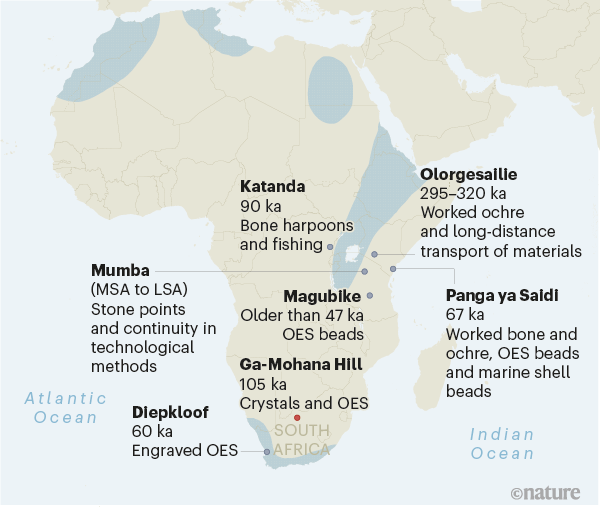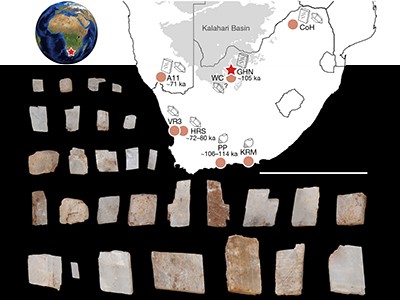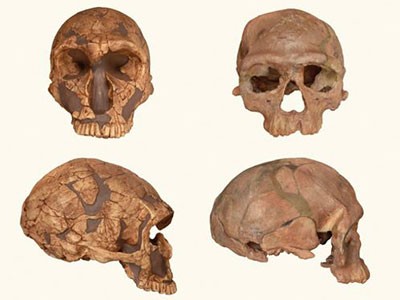
Ostrich eggshells and crystals gathered more than 100,000 years ago shed light on the cultural evolution of early humans. Found in South Africa’s interior, they reveal that technological innovations occurred beyond its coast.
Ex Africa semper aliquid novi, the ancient Roman Pliny the Elder once remarked — there is always something new from Africa. Writing in Nature, Wilkins et al.1 present an example of such news in their report of material excavated from a rock shelter in a northern inland region of South Africa. The objects they found suggest it is time to revise current thinking about the emergence of cultural innovations among early human populations.
In the 1980s, researchers presented new ideas about the origins of our species, Homo sapiens. These relied on newly developed techniques such as optically stimulated luminescence, which can accurately date sites that are more than 50,000 years old (the age limit for radiocarbon analysis). These ideas were also rooted in the study of genetic diversity. The evidence came from energy-providing organelles in the cytoplasm called mitochondria, which contain DNA inherited through the female line. Some mitochondrial DNA does not encode protein, and tracking the rate of change as this DNA accumulates mutations over time provides a ‘molecular clock’. A study of mitochondrial DNA in living people led to the conclusion that we all share a last common ancestor, nicknamed mitochondrial Eve, who was probably African and lived 200,000 years ago2.
By 1988, researchers were arguing3 that the question of the origins of modern H. sapiens had been answered, and those authors then proposed what became called the Out of Africa 2 theory. This suggested that our direct ancestors evolved exclusively in Africa, and that, sometime after 50,000 years ago, some of their descendants left the continent and colonized the globe, interbreeding with hominins (human relatives) in Eurasia.
Key sites associated with modern human fossils in Africa were re-dated, and at some early sites, innovative technologies were found. This suggested that Africans around 200,000 years ago, and perhaps earlier, were already modern, both anatomically and culturally. But, generally, they relied mainly on the same kind of flaked stone tool that their hominin cousins, the Neanderthals and Denisovans, were producing at the same time in Eurasia. In sub-Saharan Africa, this technology is referred to as Middle Stone Age (MSA). In Eurasia and northern Africa, similar types of artefact belong to what is termed the Middle Palaeolithic. Both industries date to between around 300,000 and 30,000 years ago4. Current appraisals of archaeological, fossil and genetic data confirm these ideas5, and also support the pre-eminent part that Africa played during the later stages of human evolution.
Archaeological evidence indicating signs of modern humans outside Africa is associated with the onset of the Upper Palaeolithic, between 40,000 and 50,000 years ago. It is defined by a wide range of technological innovations: portable art, and, eventually, cave paintings and engravings; the first non-stone (such as bone or horn) tools; the earliest known examples of jewellery; as well as evidence for major changes in lifestyle and resource acquisition. This was once seen as evidence for the ‘human revolution’, a quantum leap in cultural evolution that could be associated only with truly modern people. Unsurprisingly, researchers tried to find similar evidence in African MSA and Middle Palaeolithic sites. Given that anatomically modern people were living there, where was the equivalent of the Upper Palaeolithic? But throughout Africa, the archaeological evidence is patchy. Some Upper Palaeolithic elements are present, but they come and go, popping up and then disappearing from a region, only to reappear elsewhere thousands of years later.
Part of the problem is that only a few African regions have been studied in detail, mainly at the temperate northern and southern ends of the continent (Fig. 1). The other intensively investigated locations are where researchers would reasonably expect to uncover ancient remains, such as sites with natural landscape erosion that has exposed fossils and stone artefacts. These key localities are in the Gregory Rift Valley of Ethiopia, Kenya and Tanzania6and the dolomite limestone caves of South Africa, referred to as the Cradle of Humankind7. But these two regions contain records of the very earliest stages of human evolution. The MSA records are most commonly found in rock shelters and caves.

Figure 1 | Some African archaeological sites associated with the Middle Stone Age. Certain mostly coastal regions (cross-hatched shading) have a long history of excavations that have shed light on the evolution of early human populations. By contrast, the named inland sites have been investigated only during the past three decades. These inland studies have revealed notable technological innovations8–14during the Middle Stone Age (MSA), which occurred between 300,000 and 30,000 years ago. Wilkins et al.1 report the discovery of ostrich eggshell (OES) fragments and crystals in a rock shelter at Ga-Mohana Hill, which suggests that humans collected unusual objects by at least 105,000 years ago (105 ka). All these discoveries show that MSA innovations were varied and variable, in time and space, and indicate the need to survey and study other parts of the continent. LSA, Late Stone Age; after 40,000 years ago.
There has been a reluctance to investigate new areas, perhaps because it is easier to continue working somewhere that has already yielded results, rather than risk going elsewhere and finding nothing notable. Figure 1 shows MSA sites located away from conventionally studied regions that have been investigated in the past three decades. These excavations have revealed surprising evidence8–15, ranging from early ostrich eggshell beads and engraved shell containers, to bone and stone tools shaped like spear tips, or possibly even bows and arrows. But the full range of Eurasian Upper Palaeolithic technologies has never been found at a single African site.
In South Africa, researchers have learnt most about the MSA from coastal sites, including Klasies River and Blombos Cave. The people who created these sites used a lot of shellfish and fish15. This has led some to conclude that marine foods had a major role in brain and behavioural evolution, generally producing truly modern human populations.
But what can we learn about the interior of Africa during the MSA? Wilkins et al. report some unexpected finds in a site at Ga-Mohana Hill (Fig. 1) on the edge of the Kalahari Desert, 665 kilometres from the coast. They discovered items assumed to have been used in an ornamental manner, perhaps indicating an early example of ritualistic symbolic behaviour. The authors report a long archaeological sequence of finds, interspersed with layers of a type of limestone called tufa, which were dated by uranium–thorium analysis. Moreover, the tufa enabled the authors to reconstruct past environments. This analysis reveals a number of wet and lush ‘green Kalahari’ periods, reminiscent of the periods of green landscape associated with the Sahara16and Arabia17.
Wilkins et al. dated some sediments using optically stimulated luminescence. One layer from Ga-Mohana Hill, around 105,000 years old, contained 42 burnt ostrich eggshell fragments and 22 calcite crystals. The items in this possible hoard of material do not show signs of intentional modification (the burning is proposed to have occurred naturally). The authors report that such crystals have never been found in southern African habitation sites more than 80,000 years old. Wilkins and colleagues systematically examined all the reasons why these pieces might be present there. After dismissing all possible natural explanations, in the same way that forensic researchers eliminate alternative scenarios during an investigation, they were left with only one conclusion — people intentionally collected such non-utilitarian objects. Their deposition presumably had some symbolic purpose; a sign that their collectors were behaviourally modern people.
Do any other early African sites offer similar finds? In western South Africa, Diepkloof Cave8 yielded many burnt and engraved pieces of ostrich eggshell that are around 60,000 years old. There, and at Ga-Mohana Hill, the shells might be the remains of ancient water containers, which are commonly found at later sites. If so, their prime purpose might have been functional, rather than symbolic. Given the age of the objects that Wilkins et al. found, it might be unsurprising that the eggshell material is not decorated, as it is at Diepkloof, or that it was not turned into beads, which happened starting around 50,000 years ago at sites such as the Magubike9 rock shelter in Tanzania and Panga ya Saidi10,11, a cave complex near the Kenyan coast with layers of artefacts spanning the past 78,000 years.
Wilkins and colleagues say that their discoveries suggest it is imperative to investigate sites in the interior of southern Africa. In East Africa, I would say we have the opposite problem, because archaeologists have hardly ever investigated coastal sites of the Stone Age. Indeed, Panga ya Saidi might be the first East African coastal site ever uncovered that contains a Stone Age sequence that spans such a long time frame. The MSA inhabitants there manufactured ostrich and land-snail shell beads, used red ochre as a pigment and collected forest resources in an environment strikingly different from the grasslands presumed to be the norm for the MSA. Panga ya Saidi was excavated with the goal of studying trading contacts across the Indian Ocean, and the extensive Stone Age deposits were an unexpected find.
Even MSA inland sites in East Africa, once thought to be well understood, have produced unforseen results. For example, at Olorgesailie in Kenya12, people transported stone raw materials long distances and used ochre to make pigments. And at Katanda in the Democratic Republic of the Congo, near a river with large catfish, people manufactured bone harpoons and other fishing gear13 to make use of these abundant river resources. The capacity to spear large fish was common in the subsequent Later Stone Age (LSA; after 40,000 years ago), but its emergence in the MSA was a surprise.
Mumba Cave14 in Tanzania was the scene of one of the first excavations in East Africa that focused on the MSA. It was directed by Norwegian archaeologist Margit Kohl-Larsen in the 1930s. At the same time, her husband Ludwig was collecting hominin fossils a few kilometres away, near Lake Eyasi, as well as at Laetoli, a site at which British archaeologist Mary Leakey and her colleagues would subsequently discover 3.75-million-year-old hominin footprints. These were produced by a bipedal individual, and are the oldest ever uncovered18. Mumba contains MSA deposits with LSA ones above. There is no sign of any sudden technological change; innovative technologies are present in the MSA and continue with few changes into the LSA14.
Wilkins et al. stress the need for a continent-wide review of the evidence for innovations during the MSA and afterwards. This is the only way we will understand the cultural evolution of our most recent common ancestors. The African fossil record for later H. sapiens5 now indicates that there does not seem to be any single pattern of technological and social development over time. Initiating surveys and excavations of lesser-known areas will help to clarify what it was that made our immediate ancestors truly modern, both biologically and culturally.
------------------------------------------
References
1.Wilkins, J. et al. Nature https://doi.org/10.1038/s41586-021-03419-0 (2021).
2.Cann, R. L., Stoneking, M. & Wilson, A. C. Nature 325, 31–36 (1987).
3.Stringer, C. B. & Andrews, P. Science 239, 1263–1268 (1988).
4.Willoughby, P. R. The Evolution of Modern Humans in Africa: A Comprehensive Guide (Altamira, 2007).
5.Bergström, A., Stringer, C. B., Hajdinjak, M., Scerri, E. M. L. & Skoglund, P. Nature 590, 229–237 (2021).
6.Gregory, J. W. The Great Rift Valley (Murray, 1896).
7.Bonner, P., Esterhuysen, A. & Jenkins, T. (eds) A Search for Origins: Science, History and South Africa’s Cradle of Humankind(Witwatersrand Univ. Press, 2007).
8.Texier, P.-J. et al. Proc. Natl Acad. Sci. USA 107, 6180–6185 (2010).
9.Miller, J. M. & Willoughby, P. R. J. Hum. Evol. 74, 118–122 (2014).
10.d’Errico, F. et al. J. Hum. Evol. 141, 102737 (2020).
11.Shipton, C. et al. Nature Commun. 9, 1832 (2018).
12.Brooks, A. S. et al. Science 360, 90–94 (2018).
13.Yellen, J. E., Brooks, A. S., Cornelissen, E., Mehlman, M. J. & Stewart, K. Science 268, 553–556 (1995).
14.Bushozi, P., Skinner, A. & de Luque, L. Afr. Archaeol. Rev. 37, 293–310 (2020).
15.Langejans, G. H. J., Van Niekerk, K., Dusseldorp, G. L. & Thackeray, J. F. Quat. Int. 270, 80–94 (2012).
16.Larrasoaña, J. C., Roberts, A. P. & Rohling, E. J. PLoS ONE 8, e76514 (2013).
17.Petraglia, M. D., Parton, S., Groucutt, H. S. & Alsharekh A. Quat. Int.382, 1–7 (2015).
18.Leakey, M. D. et al. Nature 262, 460–466 (1976).
Source: nature 31 MARCH 2021





